
Hans
Engl
|
The
International School of Luxembourg
Story:
A
New Approach to Teaching Physical
Education
The physical
education (PE) department at the
International School of Luxembourg
(ISL) has served as a leader in
the European community by dramatically
changing its approach to teaching
PE from a primarily sports-oriented
program to one that emphasizes
skill and fitness development.
To initiate this change, students,
teachers, administrators, and
parents met with a professional
PE consultant in 2003 to collectively
design a program of greater variety
and choice. The revised program
allowed students to select new
and alternative activities, while
also providing opportunities for
interested students to participate
in traditional team and individual
sports. |
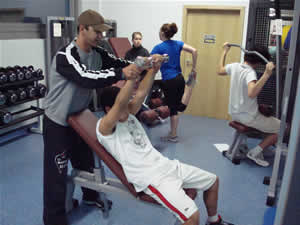 Over
the years, ISL had established and developed
a strong tradition of highly successful
sport teams within its league of the
Northwest European Council of International
Schools (NECIS). As a result, faculty
and students were skeptical about changing
the curricular focus of the PE program,
because it worked very well for developing
athletes. The program was grounded in
the philosophy that athletics require
a solid base of sport skills which are
established by 1) building a broad base
of skills in the early years, 2) refining
those skills throughout the course of
the K-12 program, and 3) culminating
in the Upper School with an emphasis
on the development of varsity teams. Over
the years, ISL had established and developed
a strong tradition of highly successful
sport teams within its league of the
Northwest European Council of International
Schools (NECIS). As a result, faculty
and students were skeptical about changing
the curricular focus of the PE program,
because it worked very well for developing
athletes. The program was grounded in
the philosophy that athletics require
a solid base of sport skills which are
established by 1) building a broad base
of skills in the early years, 2) refining
those skills throughout the course of
the K-12 program, and 3) culminating
in the Upper School with an emphasis
on the development of varsity teams.
The PE program primarily served as
a mechanism for strengthening the performances
of athletes in the competitive after
school program. This focus was similar
to traditional PE programs in North
America. PE classes were focused on
building skills associated with sports
offered in the athletics program. For
example, when the basketball, volleyball,
and soccer seasons began students were
taught those skills and games in PE.
During track & field season, students
worked out on the track during their
PE lessons.
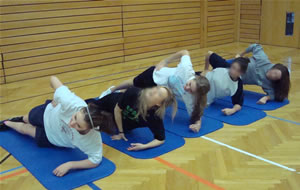 In
2003, the school became committed to
developing new standards and benchmarks
in all of its academic subjects. We
invited Kim Graber, former President
of the National Association for Sport
and Physical Education (NASPE), to steer
the process of evaluation, development,
and implementation of a new PE program
at ISL. In
2003, the school became committed to
developing new standards and benchmarks
in all of its academic subjects. We
invited Kim Graber, former President
of the National Association for Sport
and Physical Education (NASPE), to steer
the process of evaluation, development,
and implementation of a new PE program
at ISL.
Various national and international
curricula were studied and compared
during the first phase. Simultaneously,
students, staff, administrators, and
parents were invited to participate
in forums discussing the interests and
needs of a modern, alternative, and
varied PE program. Grounded in research
theories and the practical aspects of
a "best fit" for ISL model,
a new
set of standards and benchmarks
for the Middle and Upper School units
were established.
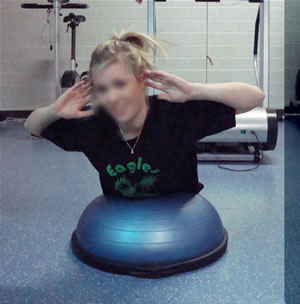 Kim
Graber visited the school again later
that year, and led another 3-day workshop.
During this workshop, the PE department
finalized the development of the new
Middle and Upper School units using
Grant Wiggins and Jay McTighe's curriculum
model "Understanding
by Design." The new program
gave the students a choice of different
activities. Middle School units
ran for 6 weeks, and offered a wide-variety
of choices in team, dual, individual,
outdoor education, and creative sport
activities. The Upper School units ran
for 12 weeks, with students having the
choice between different "core"
sports and "fitness for life"
courses. In support of the new curriculum
the school invested in equipment, such
as roller blades, so that all students
could have exposure to novel curriculum. Kim
Graber visited the school again later
that year, and led another 3-day workshop.
During this workshop, the PE department
finalized the development of the new
Middle and Upper School units using
Grant Wiggins and Jay McTighe's curriculum
model "Understanding
by Design." The new program
gave the students a choice of different
activities. Middle School units
ran for 6 weeks, and offered a wide-variety
of choices in team, dual, individual,
outdoor education, and creative sport
activities. The Upper School units ran
for 12 weeks, with students having the
choice between different "core"
sports and "fitness for life"
courses. In support of the new curriculum
the school invested in equipment, such
as roller blades, so that all students
could have exposure to novel curriculum.
Kim Graber joined us again in 2004
to help establish the Lower School units.
A wide
variety of skill activities were
developed for PS-K2, taking into account
the loco motor, manipulative, and non-manipulative
aspects. The grade
1-2 curriculum focused on space,
relationships, and effort emphasized
in the "Movement Wheel" that
was developed by George Graham and his
colleagues. Finally the grade 3-5 curriculum
was developed by creating 3-4 week units
on individual, dual, team, outdoor,
and creative sport activities that utilized
small-sided games, simplified rules,
and lead-up activities.
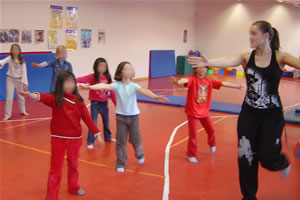 The
PE department met yet again with Kim
Graber in 2006 to review the new program,
make changes where needed, develop skill
progressions, and establish assessment
criteria and tasks for the Middle and
Upper School units. In continuation
of this process, the PE department now
organizes weekly summer workshops that
focus on improving the current program,
and continuing the development of the
assessment tasks. The
PE department met yet again with Kim
Graber in 2006 to review the new program,
make changes where needed, develop skill
progressions, and establish assessment
criteria and tasks for the Middle and
Upper School units. In continuation
of this process, the PE department now
organizes weekly summer workshops that
focus on improving the current program,
and continuing the development of the
assessment tasks.
During the process of evaluating the
"old" and creating the "new"
PE curriculum, teachers were mostly
enthusiastic, but also partly concerned
about the changes. Time was needed to
prove that the future program would
be successful and accepted by students.
Now the entire PE staff feels confident
teaching the units, and new colleagues
have no difficulty adapting to the program.
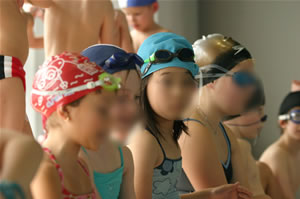 Our
athletic sports program has not suffered
by making the PE program independent
of the athletic program. To the contrary,
athletes view PE as a balance to their
after school practices, and they acquire
new movement and activity concepts.
Furthermore, the non-competitive after
school program benefited, as new PE
activities were developed and transferred
to clubs or activities outside the classroom. Our
athletic sports program has not suffered
by making the PE program independent
of the athletic program. To the contrary,
athletes view PE as a balance to their
after school practices, and they acquire
new movement and activity concepts.
Furthermore, the non-competitive after
school program benefited, as new PE
activities were developed and transferred
to clubs or activities outside the classroom.
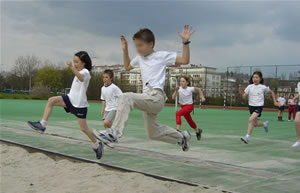 Summarizing
the PE curriculum development at ISL,
the last five years can be viewed as
a great success because all of our students
(not just the athletes) are able to
find areas of interest in the curriculum.
The Lower School program builds a strong
base of fundamental skills and abilities,
including all aspects of movements,
interactions, and variations. Middle
School students experience a wide variety
of alternative and traditional sports,
and are challenged by a choice of new
activities. Fitness for Life has become
an integral part of our sports program
in the Upper School, and encourages
students to experience and learn new
and lifelong aspects of physical activity
and fitness. Summarizing
the PE curriculum development at ISL,
the last five years can be viewed as
a great success because all of our students
(not just the athletes) are able to
find areas of interest in the curriculum.
The Lower School program builds a strong
base of fundamental skills and abilities,
including all aspects of movements,
interactions, and variations. Middle
School students experience a wide variety
of alternative and traditional sports,
and are challenged by a choice of new
activities. Fitness for Life has become
an integral part of our sports program
in the Upper School, and encourages
students to experience and learn new
and lifelong aspects of physical activity
and fitness.
resources:
Wiggins, G. & McTigh, J. (1998).
Understanding
by design (1st ed.). Alexandria,
VA: Association for Supervision and
Curriculum Development.
Graham, G., Holt/Hale, S. A. &
Parker, M. (2004). Children
Moving: A Reflective Approach to Teaching
Physical Education (6th ed.).
New York, NY: McGraw-Hill Higher Education.
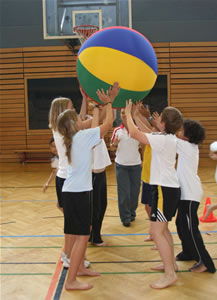 Hans
Engl: Biography Hans
Engl: Biography
Hans Engl started his position as Head
of Physical Education and Athletic Director
at the International School of Luxembourg
with over 550 students in 2003. In this
function he steered the PE curriculum
development, launched the new K-12 non-competitive
after school sports clubs, and fine-tuned
the Athletic programme for further growth
to almost 900 students. At the end of
this summer Hans Engl will take on his
new role as Athletic Director at the
International School of Zug and Luzern
in Switzerland.
In his former occupational activities
he was involved as Head of Physical
Education, sports facility coordinator,
volleyball, swimming and tennis
head coach at the International School
of Frankfurt for 5 years, after starting
his teaching career at the International
Primary School of Zurich
and head ski coach at the American International
School of Zurich, Switzerland, in 1996.
Before commencing his profession, Hans
Engl gained
language and coaching experiences as
an exchange student at the University
of Las Palmas, Spain, and a trainer
for his University Sports Centre.
Graduating in Physical Education, Mathematics,
Educational Sciences and Psychology
at the University of Göttingen,
Germany, Hans Engl took a Masters degree
researching the effects of training
on sleeping patterns, published in the
International Journal of Sports Medicine.
Born in Munich, Germany, in 1967, he
visited a local Primary and High school,
before traveling overseas, working as
a part-time ski instructor and organizing
summer and winter camps.
(pelinks4u
home) |



